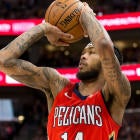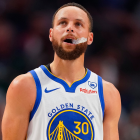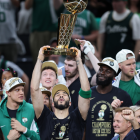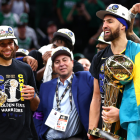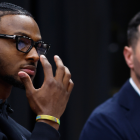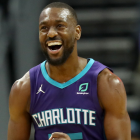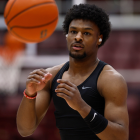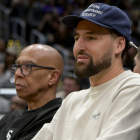"If only he could shoot," is the NBA's most common parlor game. It applies to almost literally every player in the rapidly shrinking pool of those who don't make many 3-pointers. Giannis Antetokounmpo just won the MVP Award and most of the offseason conversation surrounding him was based around imagining how good he might one day be if his shots ever started to fall. From Ben Simmons to Lonzo Ball to Markelle Fultz, the list goes on and on. Conscientious objectors no longer exist. Either you already shoot, or there is speculation about what might happen when you eventually do shoot.
Brandon Ingram was always a shooter. He just didn't shoot as often (only two 3-point attempts per game as a Laker) or as effectively (32.9 percent from behind the arc in that time) as the basketball world expected when he was picked No. 2 overall in 2016. Once compared to Kevin Durant, Ingram struggled to fit alongside the ball-dominant LeBron James without a consistent jumper. That eventually pushed him into the "if only he could shoot" camp.
An offseason trade to the New Orleans Pelicans paired him with another superstar forward who would need the ball in Zion Williamson. With Ball still his teammate, Ingram was realistic about what fitting in with the No. 1 overall pick would mean. "It's important for me to be ready when he comes back," Ingram told CBS sports. "To create for others." Succeeding with Zion meant spacing for Zion. Hitting 3s became a priority.
Now he does so at an elite rate. Ingram is taking six 3-pointers per game and making over 40 percent of them. He is ranked in the 83rd percentile league-wide in terms of spot-up efficiency, per Synergy Sports, but maintains that efficiency despite carrying an enormous load for the Pelicans as an isolation and pick-and-roll scorer, and in doing so, he has seemingly set a template for every other "if only he could shoot" player to escape their offensive purgatory and join the modern NBA.
The tweaks needed to fix Ingram's shot were relatively minor. After all, he has always been a natural scorer. If anything, that was the problem. "Sometimes Brandon goes back and forth between two or three different follow-throughs," Ingram's trainer, Raphael Edwards, explains. "He has a good touch, so sometimes if he's making shots, it can trick him." Consistency has been the key to Ingram's success this season, particularly with that follow-through. When shots are going in, he snaps his wrist, and two fingers are following the ball into the rim.
That follow-through has led to the best free-throw shooting season of Ingram's career. After never reaching 69 percent in three seasons with the Lakers, he is hitting 87 percent of his attempts at the line as a Pelican. When he misses, like clockwork, Edwards tells me, it's due to a "flat follow-through." Watch Ingram's hand on a miss in the same game. It's completely flat.
Those hands are doing more than just shooting the ball. They're an integral part of the process leading up to shots, though you wouldn't know it from watching Ingram in the past. "You're getting a lot of free opportunities to shoot, but you're not ready to shoot," Edwards told Ingram. "I said, get your feet ready, hands ready, left-right, then let it go."
Too often, last season in particular, Ingram simply wasn't ready to shoot when the ball came to him. It was as if he could not begin processing how to attack a defense until the ball was in his hands.
It was a natural reaction to Ingram's station as an isolation scorer. In the past, he could afford to be patient. But playing alongside James can turn just about anyone into a catch-and-shoot player. Where he once bristled at such a role, he now takes advantage of such opportunities and actively seeks them out with a perfect shooter's posture. As he prepares for a spot-up shot now, he is crouched and his hands are ready to catch and fire.
Where most players are relegated to catch-and-shoot duty, Ingram uses it to enhance the rest of his game. "I think it's important for me to be decisive in a bigger role," Ingram said, and the numbers back that up. Ingram is averaging a career-low 3.51 seconds per touch and 2.56 dribbles per touch. Not coincidentally, his also averaging a career-high 1.07 points per possession in isolation and 0.92 points per possession as a pick-and-roll ball-handler.
Defenses know that Ingram is not only capable of making those quick shots, but more than willing to take them, and have to defend him accordingly. His instincts now seem even hardwired to shoot, which just wasn't the case when he was a Laker.
Hesitance from behind the arc was obvious from a mechanical perspective. His footwork, at times, was completely counter-intuitive.
"He and I always used to go back and forth, because he felt like he shot better stepping into it right-left," Edwards said. "I was like 'you're right-handed. No righties shoot better that way.'" Yet traces of that preference lingered in his shot, particularly on the move. He had trouble keeping his left foot set at times, almost instinctually wanting to step in with it.
That problem has been cleaned up now. In catch-and-shoot settings, his feet are squared before the ball arrives, leading into a much more fluid shooting motion.
When he has the room to fully step into a shot, it comes in a single motion. Left, right, fire.
The tweaks are hardly revolutionary. As much as shooting is an art, there are elements of science. Release the ball at the right angle with the right amount of power applied and it is going to go into the hoop. Everything that is working for Ingram as a shooter has worked for countless players in the past and will for countless others in the future. Fundamentals never go out of style.
But knowing the fundamentals is one thing. Implementing them when you've found such success across the rest of your game is quite another. Any player can develop a shot. That Ingram did speaks to something within him that many other players lack. Humility. As Ingram began the process of retooling his shot last season, Edwards gave him a simple mindset:
"Literally the first couple of weeks, I told him, 'I don't care if you make this shot or not. What I want to see is the preparation for the shot. I want to see your feet squared up, your wrist snapping, two fingers in the rim, a high arc. I want every shot to go over that white box and come down. I want you to look comfortable.'"
It takes some misses to develop that comfort. It takes time to build these habits. But as Ingram has proven, it does more than just help you make shots. It enhances everything else a player does on the floor. And with an All-Star berth now looking like a near certainty, it is a blueprint that players league-wide should be trying to follow.









